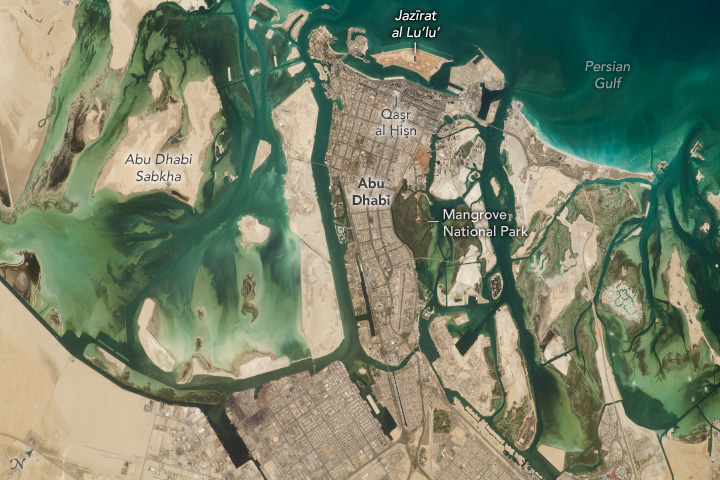Abu Dhabi
Oct 3, 2023 / NASA – Earth Observatory / Story by NASA Earth Observatory
An astronaut aboard the International Space Station took this nadir (straight down) photograph of Abu Dhabi while orbiting above the United Arab Emirates (UAE) in the Middle East. Abu Dhabi is the capital of the seven emirates that compose the UAE and is located on the coast of the Persian Gulf.
Abu Dhabi was built around the Qaşr al Ḩişn (Qasr al Hosn) fort constructed in the late 1700s to protect what was a small fishing community. Prior to the formation of the UAE in the 1970s, Abu Dhabi was a municipality of less than 62,000 people. The region experienced a rapid population increase over the past five decades due to its role in the petroleum and financial industries, which enabled the city’s population to grow to about 1.5 million people by the early 2020s.
With increasing urbanization of Abu Dhabi, several artificial islands were built in the Persian Gulf to provide additional land for development. Jazīrat al Lu’lu’, a 4.2-square-kilometer (1.6-square-mile) artificial island north of the city, was completed in the early 1990s for commercial development. Although still largely undeveloped, the island protects the city against the Persian Gulf’s high tides.
The landscape of the Abu Dhabi emirate is mainly composed of wind-blown sand, mangroves, rocky outcrops, and intertidal flats. The Abu Dhabi Sabkha, visible along the coastline as brown, non-vegetated land, was produced by wind erosion of ancient dunes and the deposition of tidal sediments. Sabkhas are flat coastal areas that are characteristically high in salt. The abundance of salt in the soil limits the ability of vegetation to develop on the sabkha.
In contrast to the barren sabkha, green mangrove forests are present along the coastline as well. Mangrove forests are regions of shrubs and trees with dense root systems that protect the intertidal zones from coastal erosion. Mangrove National Park is a protected natural area along the eastern coastline that provides habitat to aquatic species including the grey mangrove tree (Avicennia marina), the western reef heron (Egretta gularis), and the hooded oyster (Saccostrea cucullata).
Astronaut photograph ISS069-E-22976 was acquired on June 17, 2023, with a Nikon D5 digital camera using a focal length of 400 millimeters. It is provided by the ISS Crew Earth Observations Facility and the Earth Science and Remote Sensing Unit, Johnson Space Center. The image was taken by a member of the Expedition 69 crew. The image has been cropped and enhanced to improve contrast, and lens artifacts have been removed. The International Space Station Program supports the laboratory as part of the ISS National Lab to help astronauts take pictures of Earth that will be of the greatest value to scientists and the public, and to make those images freely available on the Internet. Additional images taken by astronauts and cosmonauts can be viewed at the NASA/JSC Gateway to Astronaut Photography of Earth. Caption by Cadan Cummings, Jacobs, JETS Contract at NASA-JSC.
